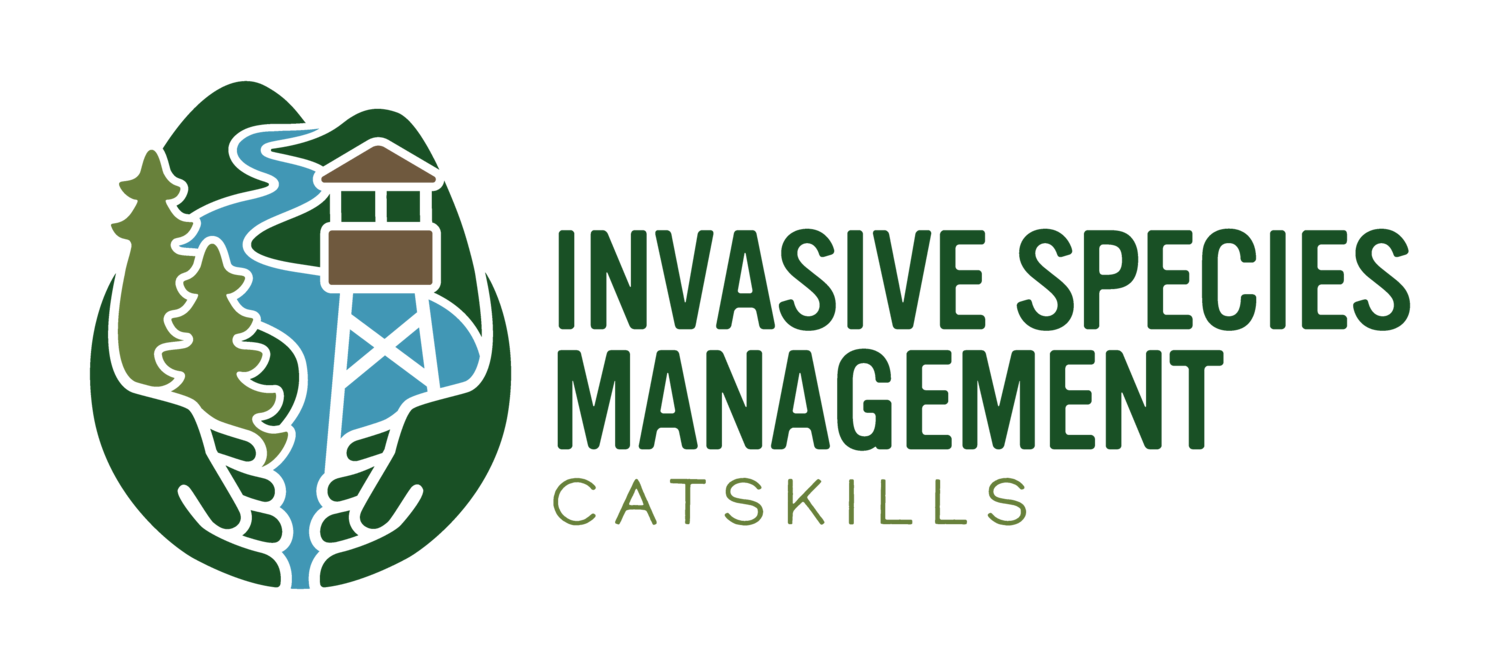CURRENT CRISP Invasive Species Tier List
The New York Natural Heritage Program, in partnership with the NY PRISM network, has revised the New York State and regional tier lists representing invasive species priorities using a newly standardized assignment method. The new tier lists incorporate number of known infestations from iMapInvasives and other invasive species databases, assessment of potential socio-economic and ecosystem impacts, and feedback from subject matter experts. This new method allows for a strong data-driven approach common to all regions, which can be modified by expert knowledge about infestations and species within each region.
Click here to see a story map explaining the tier lists in more detail, and click here to explore the tier lists on the NY iMapInvasives website.
Beech Leaf Disease
Beech leaf disease striping occurs between leaf veins and is most visible from the underside of the leaf. Picture courtesy of NYS DEC.
Description and Threat
Beech leaf disease is a syndrome associated with a foliar nematode that can affect both native and ornamental beech. Since it has only recently been discovered, research is still needed to understand the full cause of the disease, how it spreads, and potential management techniques.
Beech leaf disease can cause mortality in young trees in two to three years and larger overstory trees in six to ten years. American beech is a common and widespread tree species in New York, and provides nuts and nesting areas for wildlife species.
Severely affected leaves appear shriveled, yellowed, and may have necrotic (dead) patches. Picture courtesy of NYS DEC.
Signs and Symptoms
Symptoms of this disease are seen in the leaves and include striping, curling, and/or leathery texture. These symptoms may be visible from leaf out in May until leaves fall off in October and are most easily noticed by looking up into the forest canopy. Dark stripes are located between the leaf veins and are most visible on the underside of leaves when they are held up to the light. In early infestations, only a few leaves may be affected. Severely affected leaves appear withered, dry, and yellow. A single tree can contain both heavily infected and unaffected branches.
REPOrt Sightings
Beech leaf disease was detected in Sullivan County, in the CRISP region in 2022 and has now spread to other counties in CRISP. This disease is expected to spread and we’re asking you to please report. If you think you have seen the signs of beech leaf disease:
Take photos of symptoms, as well as the tree's leaves, bark, and the entire tree if possible. Photos of leaves held up to the light, or taken through the canopy, make it easier to identify BLD symptoms.
Submit a report through iMapInvasives . Beech leaf disease is listed as the nematode Litylenchus crenatae maccannii.
You can also report by emailing photos and location information to foresthealth@dec.ny.gov.
At this time, there are no known ways to control or manage beech leaf disease. DEC is continuing to collect public reports to determine where beech leaf disease is present across the state.
DEC Forest Health has conducted a pilot study to research insect communities associated with beech that might spread the disease. DEC has also joined a multi-state initiative led by the US Forest Service to monitor disease progression through plots set up across the state.
Northern Snakehead
Northern snakeheads have been caught on the Delaware River and in the BashaKill in Sullivan County
Snakeheads prey on and compete with other fish and could impact the Upper Delaware River Watershed. Snakeheads are voracious predators that could disrupt food webs and aquatic ecosystems.
If you catch a snakehead, you are requested to:
DO NOT RELEASE IT back to the water, Kill the fish immediately
If possible, take pictures of the fish, including close-ups of its mouth, fins, and tail
Note where it was caught (waterbody, landmarks or GPS coordinates) and
Report the catch to the regional NYS DEC fisheries office, DEC's Invasive Species Bureau at isinfo@dec.ny.gov or (518) 402-9425 or submit a report through iMapinvasives
For more info about the invasive Northern Snakehead, see www.dec.ny.gov/docs/lands_forests_pdf/nsnakeheadfs.pdf
Credit: https://www.smithsonianmag.com
Invasive Alert: Jumping Worm (Amynthas spp.)
The Jumping, or Crazy Worms (Amynthas spp.) impact our forest soils and may consume the forest duff layer, which provides habitat for native plants and wildlife. These worms may also be destructive to turf and ornamental plantings. We only have a few reports in our area, but know that the species is under-reported. Identification and background information on Jumping Worms is now available from the Cornell Cooperative Extension Columbia and Greene Counties Master Gardeners here. and you can download a homeowner’s guide, from the JWorm Working Group here. Make sure you check out the cool clamation video here
If you see a Jumping Worm in the CRISP region, please report it to http://www.nyimapinvasives.org/ Here are confirmed observations: https://tinyurl.com/y9cbtdvu
You can help slow the spread of Jumping Worms:
Do not move soil. Clean all soil off of tools, equipment & shoes
Do not use compost or mulch of unknown origin
Limit leaf blowing or moving leaves, cocoons (eggs) stick to leaves
Credit: https://dnr.wi.gov
Early Detection
Once an invasive species becomes established, the only remediation action possible is the partial mitigation of negative impacts of the invasive. The goal of Early detection and Rapid Response (EDRR) efforts are to increase the likelihood that invasions will be eradicated before they become established. A CRISP priority early detection list was developed based on the following criteria:
Species is capable of invading forest or riparian habitats such as those present within CRISP
Species can be spread within the region, and
Known, problematic infestations already established within CRISP.
CRISP Priority Early Detection Species
Terrestrial
Persicaria perfoliata Mile-A-Minute
Brachypodium sylvaticum Slender False Brome
Aralia elata Japanese Angelica-tree
Syringia reticulata Japanese Tree Lilac
Impatiens glandulifera Himalayan Balsam
Aquatic
Hydrilla verticillata Hydrilla
Ludwigia peploides Floating Primrose-willow
Hydrocharis morsus-ranae Common Frogbit
Nymphoides peltata Yellow Floatingheart
Egeria densa Brazilian waterweed
Cabomba caroliniana Carolina fanwort
Early
Detection
Campground
Survey
Surveys were performed for Early Detection terrestrial plants and for forest pests during the summers of 2016 and 2017. Through a program established by New York State Department of Environmental Conservation and SUNY College of Environmental Science and Forestry, Nicolas Echevarria was selected as the 2017 Catskill Invasive Species Campground Steward and worked for 14 weeks beginning on May 22nd. Nico performed Early Detection surveys for high priority Early Detection terrestrial plants and forest pests on the eight DEC Campgrounds in the Catskills region. All high-risk areas at each campground, such as campsites, buildings and trailheads, were surveyed between June 8th and July 27th. Campgrounds are a high-risk area for invasive species infestation because visitors traveling from outside our region can potentially be vectors for invasive species movement. One targeted plant infestation was found-Himalayan Balsam was found along the boundary of the Beaverkill Campground.

CLEAN, DRAIN, AND DRY BOATS, KAYAKS, CANOES AND ALL FISHING GEAR BEFORE MOVING THEM TO A NEW WATERBODY. YOU NEVER KNOW WHAT COULD BE HITCHHIKING ALONG WITH YOU.
Learn More Here

Aquatic Invasive
Discovered in
Cayuga Lake
September 5, 2013:
The aggressive aquatic plant Water thyme, Hydrilla verticillata, was found last week in Cayuga Lake. Hailing from Asia, many scientists consider Water thyme the most problematic of all aquatic invasive plants. In favorable conditions, the plant is capable of growing an inch a day, smothering native plant species and clogging waterways.
Water thyme tolerates a range of growing conditions and can inhabit water from a few inches deep to thirty feet in depth. Although the plant prefers slow moving water, it has recently been found in the fast moving waters of Fall Creek, also in Cayuga County. Its recent foothold in Cayuga Lake makes it unlikely Water thyme will be exterminated in New York since Cayuga Lake holds too much water for known eradication measures.
Introduced by the aquarium trade in Florida in the 1960s, Water thyme currently is present in numerous states including Connecticut, Massachusetts, and of course, New York. This most recent find in Cayuga Lake highlights the importance of early detection and rapid response reporting when it comes to preventing invasive species from taking over our waterways. If detected early, invasive species are controllable and management costs can be kept low.
For more detailed information about water thyme and other aquatic invasives visit www.nyis.info.
Credit: https://www.tripadvisor.com








